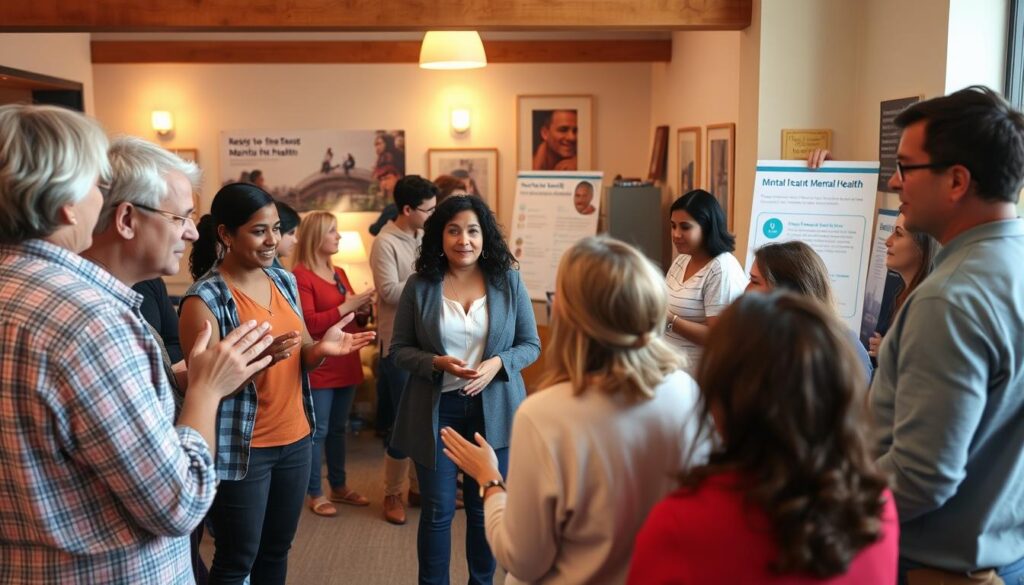Discover Your Path to Depression Treatment Resources

Feeling weighed down by emotions you can’t shake? Like every day feels like climbing a hill with no peak in sight? You’re not alone. Depression can make even small tasks feel impossible, leaving you searching for a way forward. This article is here to guide you through the maze of depression treatment resources, giving you hope and practical steps tailored to your unique journey.
When darkness clouds your thoughts, knowing where to turn can feel overwhelming. But there are mental health support services designed to meet you exactly where you are. Whether it’s therapy, medication, or community-based programs, these resources exist to help you reclaim moments of light. Recovery isn’t a straight line—it’s a path with twists, and that’s okay. What matters most is taking that first step toward care.
Every person’s struggle with depression is different, and so is their path to healing. This guide highlights the variety of depression treatment resources available, from professional therapy to self-care practices. It’s okay to feel unsure—many have walked this road before you, and the tools here are meant to empower, not pressure.
Key Takeaways
- Depression treatment resources exist to meet you where you are, whether through therapy, medication, or community programs.
- Seeking mental health support services is a brave step toward reclaiming your well-being.
- No single path works for everyone; exploring options like support groups or online counseling can help you find what fits best.
- Recovery is personal and ongoing—it’s okay to try different approaches until you find what works.
- You don’t have to face this alone; resources are available to guide you toward hope and healing.
Understanding Depression and Its Impact
Depression is more than feeling sad. It’s a serious medical condition that affects your thoughts, feelings, and actions. There are proven treatments for depression, but first, you must recognize the problem. Learning about its symptoms and effects helps you find the right depression treatment resources early.
What Is Depression?
Depression is a mood disorder that causes persistent sadness and loss of interest. It changes your brain chemistry, making simple tasks seem too hard. Doctors diagnose it based on criteria like prolonged sadness and loss of pleasure in activities.
Signs and Symptoms of Depression
- Feelings of hopelessness or guilt
- Changes in sleep or appetite
- Fatigue or low energy
- Difficulty concentrating
Physical symptoms like headaches or digestive issues may also appear. These signs often worsen without professional care.
How Depression Affects Daily Life
Depression can disrupt work, school, or relationships. Simple tasks like showering or eating may feel impossible. Social withdrawal is common, isolating you from loved ones. Early intervention through therapy or medication improves outcomes. Evidence-based treatments for depression, such as cognitive-behavioral therapy, address these challenges effectively.
“Depression is not a weakness—it’s a health condition needing care, just like diabetes or heart disease.” — National Institute of Mental Health
Types of Depression Treatment Resources
Understanding your options is the first step toward feeling better. Depression treatment resources are designed to address symptoms through proven methods. Evidence-based treatments for depression include therapies, medications, and peer support. Let’s explore each type to find what works for you.
Therapy Options
Therapy helps you reframe thoughts and behaviors. Evidence-based treatments for depression often include:
- Cognitive Behavioral Therapy (CBT): Teaches skills to challenge negative thinking patterns.
- Interpersonal Therapy (IPT): Focuses on improving relationships and communication skills.
- Psychodynamic Therapy: Explores how past experiences influence current emotions.
Medication Options
Medications can balance brain chemistry to ease symptoms. Common choices include:
- SSRIs (e.g., sertraline): Increase serotonin levels.
- SNRIs (e.g., venlafaxine): Boost serotonin and norepinephrine.
- Atypical antidepressants: Offer alternatives for those who haven’t responded to other options.
Support Groups
Connecting with others who understand what you’re going through can make a big difference. Support groups provide:
“Sharing experiences in a group can reduce loneliness and offer practical advice.”
These groups are a free or low-cost addition to professional care, fostering accountability and hope.
Combining these options creates a personalized plan. Talk to a provider to decide which depression treatment resources align with your needs.
Finding Professional Help
Choosing the right therapist is a big step. Start by using a therapist directory for depression to find licensed professionals near you. Look for credentials like LCSW or LMFT. Also, read client reviews to see if their approach fits you.
How to Choose a Therapist
- Search therapist directories for depression or ask your doctor for referrals.
- Check their specialties, experience, and availability.
- Request a consultation call to discuss your goals and comfort level.
What to Expect in Therapy
Most sessions start with talking about your mood and challenges. You’ll set goals like improving coping skills or addressing past trauma. Therapists might use CBT or mindfulness exercises.
Progress is tracked through regular check-ins and goal reviews.
Online Therapy vs. In-Person Therapy
Both options have their benefits:
- Online therapy for depression: Offers flexibility with video calls. Ideal for those with mobility or location barriers.
- In-person therapy: Provides face-to-face connection, helpful for those needing a structured environment.
Many people choose to combine both approaches based on their schedule and comfort.
The Role of Medication in Treatment
Medication is a key part of evidence-based treatments for depression. It can help balance brain chemistry and lift your mood. Your healthcare provider will help choose the right medication for you.
Common Types of Antidepressants
- SSRIs (e.g., fluoxetine, sertraline): Increase serotonin levels.
- SNRIs (e.g., venlafaxine, duloxetine): Target serotonin and norepinephrine.
- Tricyclics: Older options sometimes used for treatment-resistant cases.
- MAOIs: Require dietary restrictions and close monitoring.
“Medication works best when tailored to your unique situation. Regular check-ins with your doctor are key.”
Potential Side Effects
Common side effects include nausea, drowsiness, or changes in appetite. Some people might experience dry mouth or trouble sleeping. If symptoms last, tell your doctor—they might change your prescription.
When Medication is Necessary
Medication is key if symptoms severely affect your daily life or therapy isn’t enough. It’s often suggested for moderate-to-severe cases or when there’s a risk of harm. Always talk about risks and benefits with your healthcare team.
Remember, depression treatment resources like medication are part of a bigger plan. Be patient—effects may take weeks to show. Never stop or change doses without professional advice.
Exploring Alternative Treatment Options
Looking beyond traditional treatments, holistic methods can boost your recovery. These methods combine physical, mental, and lifestyle changes to fight depression. Here are three science-backed practices to try today.
Mindfulness and Meditation
Mindfulness helps your brain stay in the moment, reducing worries. Here’s how to start:
- Begin with 5-minute guided sessions on apps like Headspace or Calm
- Use breathwork to calm down when stressed
- Try body scans to release physical and mental tension
Exercise and Physical Activity
Exercise boosts serotonin and endorphins, improving mood. Even small amounts help:
- Walk briskly for 30 minutes each day to feel better
- Try yoga or tai chi for both physical and mental calm
- Do strength training twice a week to build strength
Nutritional Approaches
What you eat affects your brain’s chemistry. Certain diets and nutrients can help:
- Eat Mediterranean foods rich in omega-3s (from fish or flaxseeds) for brain health
- Avoid processed foods to avoid energy drops
- Get a dietitian for a meal plan tailored to you
Combine these practices with professional help for a complete approach. Small, consistent steps lead to big changes.
Utilizing Community Resources
Community support for mental health is more than just finding help. It’s about making connections. Many neighborhoods have mental health services tailored to your needs. Start by looking into local options to feel more connected and less alone.

Local mental health services include clinics, hospitals, and non-profits. Look up directories like National Alliance on Mental Illness (NAMI) or ask your doctor for suggestions. Many offer affordable or free services for those who need them.
When emergencies happen, hotlines and crisis resources are there to help. Keep these 24/7 options in mind:
| Resource | Contact |
|---|---|
| 988 Suicide & Crisis Lifeline | Call or text 988 |
| Crisis Text Line | Text “HELLO” to 741741 |
Workshops and support events are great for learning and sharing. Use platforms like Eventbrite or check community boards for events. Many libraries or community centers offer free sessions.
Looking into these options takes courage, but you’re not alone. Every step you take brings you closer to the right help for your life.
Online Resources for Depression Treatment
Digital tools can help you manage depression. Self-help resources and online therapy are flexible and easy to use. They fit well into your daily life.
We websites with reliable information
Start with trusted sites like HelpGuide or NAMI. They offer guides on symptoms, treatment, and coping. You’ll find checklists, recovery journals, and links to local services.
Mobile apps for mental health
Apps like Woebot or Headspace offer self-help for depression. They have features such as:
- Mood tracking and analysis
- Guided breathing exercises
- CBT-based activities
- Emergency contact tools
Many apps work with health trackers. This gives you a full view of your well-being.
Virtual support groups
“Online communities provide 24/7 connection, reducing feelings of isolation.”
Join groups on platforms like ADAA or through Zoom. These spaces are safe for sharing experiences. You can connect with others facing similar challenges.
Always check the credentials and privacy policies before using these tools. Using them with professional advice can lead to better results.
The Importance of a Support Network
Connecting with others is key when dealing with depression. “No one should face mental health challenges alone,” says the National Alliance on Mental Illness (NAMI). It’s not just about finding help. It’s about building a strong base to rely on when things get hard. Here’s how to grow your network and use it wisely.

Building a Support System
First, find people who make you feel better:
- Connect with friends, family, or mentors you trust.
- Look for local or online mental health groups (like NAMI’s support groups).
- Check out peer-led communities like 7 Cups or Crisis Text Line for anonymous support.
Communicating with Friends and Family
Talking about your needs takes courage. Here are some tips for coping with depression:
- Be open: “I’m struggling, and I need someone to listen—not fix things.”
- Set boundaries: “I appreciate your concern, but I need space right now.”
- Use “I” statements: “I feel better when we talk about small goals, not just my diagnosis.”
Navigating Conversations About Depression
| Situation | What to Say | Why It Helps |
|---|---|---|
| A loved one dismisses your feelings | “I’m not imagining this—it’s a medical condition, like diabetes.” | Encourages empathy by reframing depression as a health issue. |
| Someone offers unsolicited advice | “Thank you, but my therapist and I are creating a plan together.” | Asserts your agency while redirecting to professional guidance. |
| Conversations turn to guilt (“You’re making this about you”) | “My well-being affects everyone I care about. Let’s work on this together.” | Frames mental health as a shared concern, fostering collaboration. |
Every talk is a chance to strengthen your network. Small steps, like joining a support group or sharing one coping strategy at a time, build resilience over time.
Self-Care Strategies for Managing Depression
Small, consistent actions can make a big difference in your mental well-being. Self-help resources for depression often highlight everyday practices that build resilience. Coping strategies for depression like routines and creative activities can become lifelines during challenging moments.
“A routine creates stability. Creativity offers hope.”
Daily Routines that Help
Structure brings calm to chaotic days. Try these steps:
- Wake and sleep at the same time daily
- Plan 15 minutes of sunlight each morning
- Prepare simple meals to maintain energy levels
The Power of Journaling
Writing thoughts helps untangle emotions. Keep a notebook or app like Daylio to track:
- Mood shifts and triggers
- Positive moments to revisit
- Progress over weeks and months
Creative Outlets and Hobbies
Engaging in creativity redirects focus from negative thoughts. Choose activities that feel manageable:
| Activity | Benefits | Time Commitment |
|---|---|---|
| Gardening | Encourages mindfulness and accomplishment | 20-30 minutes weekly |
| Cooking | Boosts focus and sensory engagement | 30 minutes daily |
| Dance or yoga | Combines movement with mental reset | 15-20 minutes daily |
Remember: Progress isn’t linear. Celebrate small wins like finishing a journal entry or trying a new recipe. Every effort strengthens your coping strategies for depression over time.
Overcoming Barriers to Treatment
Getting help doesn’t have to seem impossible. Many face challenges like stigma, cost, or busy schedules. But, there are solutions. Here’s how to move forward with confidence.
Addressing Stigma
Feeling judged can stop you from seeking care. Try these steps:
- Learn facts about depression to replace myths.
- Join mental health support services that offer peer-led groups.
- Share experiences with trusted friends to build understanding.
Financial Considerations
Cost shouldn’t block your path. Explore:
- Sliding scale fees at community clinics.
- Insurance plans that cover therapy sessions.
- Free hotlines like NAMI’s Helpline (1-800-950-NAMI).
- Search online therapist directory for depression platforms to compare options.
Finding Time for Treatment
Making space in your schedule:
- Set small weekly goals, like a 20-minute online session.
- Ask employers about EAP programs for work-free counseling.
- Use apps to track progress between appointments.
Every step counts. Whether you’re researching mental health support services or budgeting for care, you’re not alone. Start today with tools that fit your life.
Taking the First Step Towards Recovery
Your healing journey begins today. Every step you take, like reaching out for help or trying new treatments, moves you forward. The resources here are here to support you, not push you. Take it one day at a time.
Setting Personal Goals
Start with goals that feel achievable. Maybe it’s texting a therapist or doing a 10-minute mindfulness exercise. Small victories build your confidence. Use apps or journals to track your progress and celebrate each win.
Developing a Treatment Plan
Work with your team to make a plan. Mix therapy with holistic methods like yoga or nutrition changes. Include regular check-ins or crisis hotlines to stay connected.
Your Journey to Wellness
Recovery has ups and downs. When you hit a tough spot, go back to the resources listed. Online communities, support groups, or telehealth platforms can help. Healing isn’t always straight, but every step brings you closer to balance.




